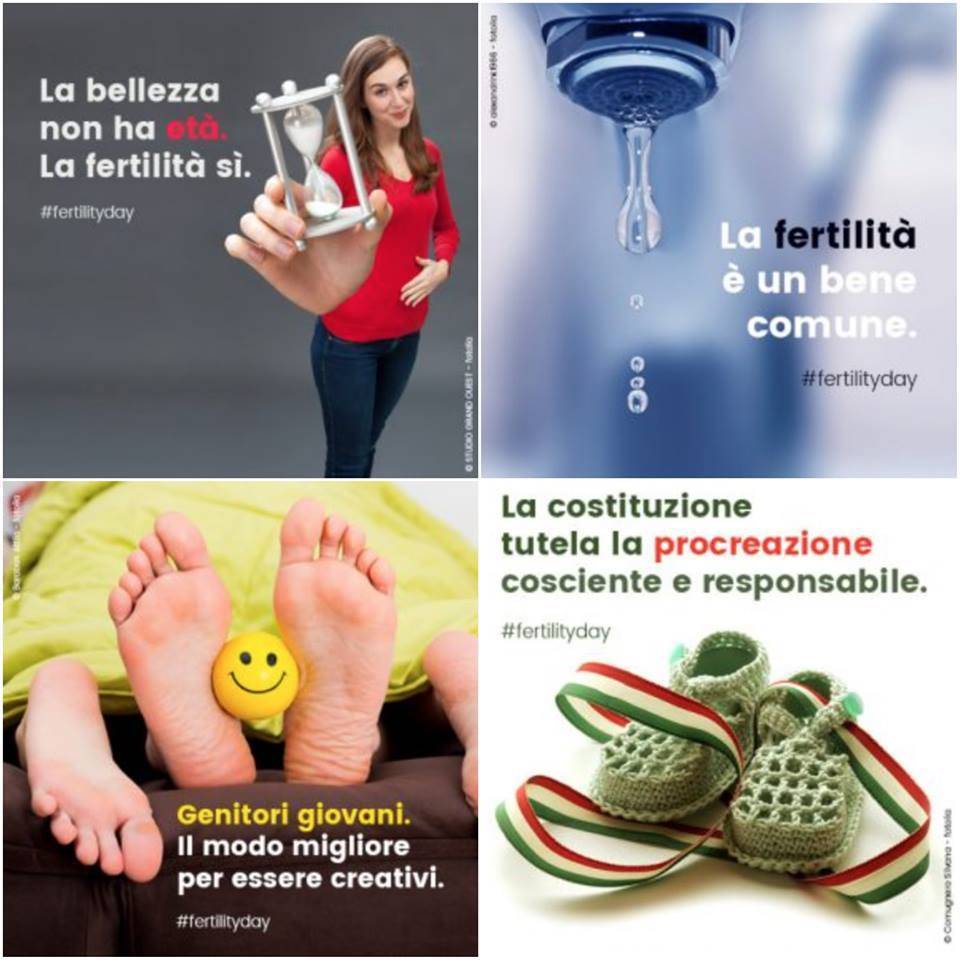
Demography is destiny, and the destiny of aging Europeans is long run death. How the demographic strategists have dealt with this varies, but the tendency in various countries is either to accept refugees en masse (the now questioned Merkel solution for Germany), or encourage home breeding through various initiatives.
The latter point became an issue in Italy when the population wonks got busy with a program of encouragement: Breed for the state; conceive in patriotic circumstances. Since the 1960s, the birth rate in Italy has fallen by half, to 488,000 babies born in 2015. Negative birth rates has been the norm for decades.
The Fertility Day was born, and it caused quite a rotten stir. On Wednesday, accusations were made that a booklet, published by the health ministry pointing out undesirable and desirable personal habits, was more than mildly racist.
The top part of the cover was positively bread white, sporting two couples of near Aryan fairness. All happy, ambitiously sexual, all hopefully fecund. The dark side of life was conveniently portrayed on the front as well, just to provide a suitably ugly contrast. Instead of horizontal collaboration in the name of the state, lounge lizards, one of them visibly black, were lighting up, decadently passing the day.
While engaging oneself in the good act of copulation (or assisted reproduction), and lighting up a reefer, are hardly inconsistent activities, such campaigns tend to be resolutely austere. Fuck, but do so with biblical purpose and concentration. It’s all a rather serious affair.
Health minister Beatrice Lorenzin, member of the New Centre Right and self-proclaimed apocalyptic Cassandra, thought she was being clever in suggesting that the photos conveyed diversity in Italy yet also making a homogenous claim. “The photos represent a homogeneity of people, as is the multi-ethnic society in which we live. Racism is in the eye of the beholder.” As is, come to think of it, racial homogeneity.
The country has borne witness to a range of posters encouraging a fertility drive. Twelve have been produced. “Beauty has no age,” goes one trite claim. “But fertility does” (La bellezza non ha età. La fertilità sì.)
Even the Italian Prime Minister has expressed irritation at the campaign run by his minister. Matteo Renzi decided to throw his colleague to the wolves by distancing himself in a radio interview. He claimed that none of his friends felt an urgency to have children after seeing such an advertisement, with only stable jobs and appropriately financed day care being the priorities to ensure more children.
“If you want to create a society that invests in its future and has children,” asserted Renzi, “you have to make sure that underlying conditions are there.”[1] Not the most earthshattering of revelations, but entirely appropriate to the standard policy maker, and one having to face the traditional impediments facing Italian families.
Sexuality and fertility tend to be minefields for policy makers. While families and sexual life should be deemed areas of autonomous endeavour, family policies rarely reflect the family as a totally private, and privatised matter. Behind every child is a demographic consideration, a population marker.
In this case, it was obvious that fertility was being treasured, the sacred grove of a society’s existence. The infertile one would invariably be cast on the outer, as would those waiting for an appropriate partner, or a more appropriate economic situation.
As author Robert Saviano noted on his Facebook page, the focus in this odd campaign was on urgency and desperation, rather than discretion and discrimination. “You are not certain that your partner is the right one? Come on, procreate, for where they eat two eat three.”[2]
When states start to fiddle the demographic picture, unevenness is a standard result. The other aspect of the fertility coin is restriction and control. When governments get involved in that field, problems can also arise.
China’s one-child policy, the classic example of fertility fiddling in action, had its backers, but it has always had its prominent detractors. The fear there was that a centrally imposed directive about breeding would be demographically disturbing. Cultural impediments, in other words, were not adjusted to cope with the aspirations.
The inadvertent consequence of that approach was a preponderant favouring of male children. The results of that all too remarkable social engineering exercise is a conspicuous shortage of brides for the surfeit of men. The availability of inexpensive ultrasound machines, notably in the countryside, also enable parents to make tactical decisions accordingly.
Then there is another side, often neglected by the panic mongers keen to see prams filled and cots populated. Aging is not necessarily a cause for crisis. The National Academy on an Aging Society has made the claim that demography need never be destiny – provided that a “reasoned set of policy choices” are put in place.[3] Sort out the care options and employment, and the babies will duly follow.
Dr. Binoy Kampmark was a Commonwealth Scholar at Selwyn College, Cambridge. He lectures at RMIT University, Melbourne. Email: [email protected]
[1] http://www.bbc.com/news/business-37254831
[2] https://www.facebook.com/RobertoSavianoFanpage/posts/10153900562276864:0
[3] http://www.civicengagement.org/agingsociety/publications/demography/index.html












































